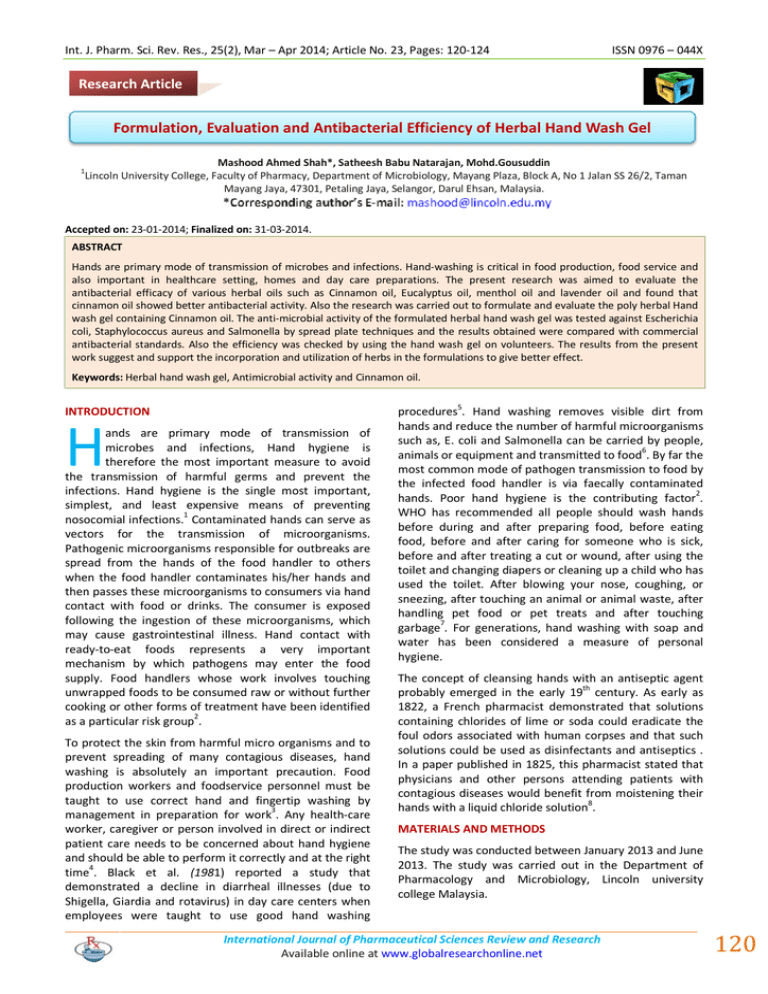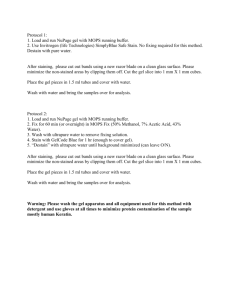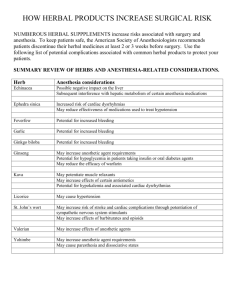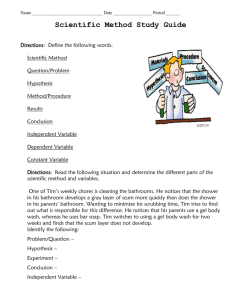Document 13309675
advertisement

Int. J. Pharm. Sci. Rev. Res., 25(2), Mar – Apr 2014; Article No. 23, Pages: 120-124 ISSN 0976 – 044X Research Article Formulation, Evaluation and Antibacterial Efficiency of Herbal Hand Wash Gel 1 Mashood Ahmed Shah*, Satheesh Babu Natarajan, Mohd.Gousuddin Lincoln University College, Faculty of Pharmacy, Department of Microbiology, Mayang Plaza, Block A, No 1 Jalan SS 26/2, Taman Mayang Jaya, 47301, Petaling Jaya, Selangor, Darul Ehsan, Malaysia. Accepted on: 23-01-2014; Finalized on: 31-03-2014. ABSTRACT Hands are primary mode of transmission of microbes and infections. Hand-washing is critical in food production, food service and also important in healthcare setting, homes and day care preparations. The present research was aimed to evaluate the antibacterial efficacy of various herbal oils such as Cinnamon oil, Eucalyptus oil, menthol oil and lavender oil and found that cinnamon oil showed better antibacterial activity. Also the research was carried out to formulate and evaluate the poly herbal Hand wash gel containing Cinnamon oil. The anti-microbial activity of the formulated herbal hand wash gel was tested against Escherichia coli, Staphylococcus aureus and Salmonella by spread plate techniques and the results obtained were compared with commercial antibacterial standards. Also the efficiency was checked by using the hand wash gel on volunteers. The results from the present work suggest and support the incorporation and utilization of herbs in the formulations to give better effect. Keywords: Herbal hand wash gel, Antimicrobial activity and Cinnamon oil. INTRODUCTION H ands are primary mode of transmission of microbes and infections, Hand hygiene is therefore the most important measure to avoid the transmission of harmful germs and prevent the infections. Hand hygiene is the single most important, simplest, and least expensive means of preventing nosocomial infections.1 Contaminated hands can serve as vectors for the transmission of microorganisms. Pathogenic microorganisms responsible for outbreaks are spread from the hands of the food handler to others when the food handler contaminates his/her hands and then passes these microorganisms to consumers via hand contact with food or drinks. The consumer is exposed following the ingestion of these microorganisms, which may cause gastrointestinal illness. Hand contact with ready-to-eat foods represents a very important mechanism by which pathogens may enter the food supply. Food handlers whose work involves touching unwrapped foods to be consumed raw or without further cooking or other forms of treatment have been identified as a particular risk group2. To protect the skin from harmful micro organisms and to prevent spreading of many contagious diseases, hand washing is absolutely an important precaution. Food production workers and foodservice personnel must be taught to use correct hand and fingertip washing by management in preparation for work3. Any health-care worker, caregiver or person involved in direct or indirect patient care needs to be concerned about hand hygiene and should be able to perform it correctly and at the right time4. Black et al. (1981) reported a study that demonstrated a decline in diarrheal illnesses (due to Shigella, Giardia and rotavirus) in day care centers when employees were taught to use good hand washing procedures5. Hand washing removes visible dirt from hands and reduce the number of harmful microorganisms such as, E. coli and Salmonella can be carried by people, animals or equipment and transmitted to food6. By far the most common mode of pathogen transmission to food by the infected food handler is via faecally contaminated hands. Poor hand hygiene is the contributing factor2. WHO has recommended all people should wash hands before during and after preparing food, before eating food, before and after caring for someone who is sick, before and after treating a cut or wound, after using the toilet and changing diapers or cleaning up a child who has used the toilet. After blowing your nose, coughing, or sneezing, after touching an animal or animal waste, after handling pet food or pet treats and after touching garbage7. For generations, hand washing with soap and water has been considered a measure of personal hygiene. The concept of cleansing hands with an antiseptic agent probably emerged in the early 19th century. As early as 1822, a French pharmacist demonstrated that solutions containing chlorides of lime or soda could eradicate the foul odors associated with human corpses and that such solutions could be used as disinfectants and antiseptics . In a paper published in 1825, this pharmacist stated that physicians and other persons attending patients with contagious diseases would benefit from moistening their hands with a liquid chloride solution8. MATERIALS AND METHODS The study was conducted between January 2013 and June 2013. The study was carried out in the Department of Pharmacology and Microbiology, Lincoln university college Malaysia. International Journal of Pharmaceutical Sciences Review and Research Available online at www.globalresearchonline.net 120 Int. J. Pharm. Sci. Rev. Res., 25(2), Mar – Apr 2014; Article No. 23, Pages: 120-124 Chemicals and Regents The Menthol oil, Cinnamon oil, Lavender oil, Eucalyptus oil and Nutmeg oil and methyl paraben and Hydroxy propyl methyl cellulose were collected from Alpha chemicals, India., Sodium lauryl sulphate, and glycerin were purchased from Scharlau, Spain. All other reagents/chemicals were used as analytical grade. Samples A. Volunteers Sample: Swabs from hand skin of volunteers without any clinical signs of infection were included in his study. B. Bacterial samples: Gram positive and Gram negative bacteria i.e. Staphylococcus aureus, Escherichia coli and Salmonella were collected from department of Microbiology, Lincoln University College Malaysia. Bacterial suspension of concentration 10CFU/ml was used. Media A. Nutrient broth and agar 1:80 and 1:100 were added respectively to the nutrient broth (Fig 5). A 50µl volume of each dilution was added aseptically into the wells of Mueller Hinton agar plates that were already seeded with the standardized inoculums of the test bacteria. All experiments were performed in triplicate. The agar plates were incubated at 37°C for 24 hours. The lowest concentration of oil showing a clear zone of inhibition was considered as the MIC. Formulation of Herbal Hand Wash Gel Various herbal hand wash gel formulation batches were prepared. (table.1)The desired concentration of gelling agent, foaming agent, emollient were measured accurately and dispersed in purified water with moderate stirrer speed. The required quantity of methyl paraben was dissolved in remaining quantity of purified water by gentle heating. Desired quantity of herbal oil, flavorent, colorant was added to the above formulation. Triethaanolamine was added to adjust the pH. The formulated hand wash gel was filled in suitable containers and stored at cool and dry place. B. MacCkonkey agar C. ISSN 0976 – 044X Table 1: Formulation of herbal hand wash gel Mueller Hinton Agar Composition (%W/V) Methods Cinnamon oil Standardization of inoculum The inocula prepared from the stock cultures, were maintained on nutrient agar at 4°C and sub cultured onto Nutrient broth using a sterile wire loop. Antimicrobial Studies of Commercial Herbal Oils The screening of anti-microbial efficacy of the herbal oils was performed on various micro organisms by using dip well method as per standard procedure. Three sterile Petri plates were taken for testing the antimicrobial activity of herbal oils against three different microorganisms i.e. Escherichia coli, Staphylococcus aureus and Salmonella. The plates were filled with MacConkey and Muller Hinton agar solution and allowed for solidification. After solidification the microorganisms from the subculture were inoculated into the nutrient agar media and five discs were inoculated with menthol oil, cinnamon oil, lavender oil, eucalyptus oil and nutmeg oil respectively. The plates were incubated at 37ºC for overnight. After 24 hours of incubation, the plates were observed for the zone of inhibition. From the zone of inhibition the anti microbial activity of formulation is estimated as shown in the tables below. (Fig 1, 2, 3 and 4) and table (2). Determination of Minimum Inhibitory Concentration (MIC) of the Cinnamon Oil The MIC is defined as the lowest concentration that completely inhibits the growth of microorganisms for 24 hrs incubation. Determination of minimum inhibitory concentration of Cinnamon oil was determined by preparing different concentrations of oil.1:20, 1:40, 1:60, Formulation code H1 H2 H3 H4 H5 H6 0.1 0.1 0.1 0.1 0.1 0.1 HPMC 1 2 3 4 4 4 SLS 1 1 1 1 2 2 Glycerin 1 1 1 1 1 2 TEA *q.s q.s q.s q.s q.s q.s Perfume q.s q.s q.s q.s q.s q.s Colorant q.s q.s q.s q.s q.s q.s Methyl paraben q.s q.s q.s q.s q.s q.s Purified water q.s to 100 ml 100 ml 100 ml 100 ml 100 ml 100 ml *q.s= quantity sufficient Characterization of herbal hand washes gel pH The pH was determined by using digital pH meter and the pH of herbal hand wash was found 6.5±0.1. Viscosity The viscosity of hand wash was determined by using digital Brookfield viscometer. Measured quantity of herbal hand wash was taken into a beaker and the tip of viscometer was immersed into the hand wash gel and the viscosity was measured in triplicate. The viscosity was found 50c Pascals. Antimicrobial studies of herbal hand wash gel The screening of anti-microbial efficacy of the formulated poly herbal hand wash gel was aseptically performed on Escherichia coli, Staphylococcus aureus, and Salmonella by using Dip well Agar Diffusion Technique described by 9 Bauer et al., 1966 and demonstrated by Cakir et al., International Journal of Pharmaceutical Sciences Review and Research Available online at www.globalresearchonline.net 121 Int. J. Pharm. Sci. Rev. Res., 25(2), Mar – Apr 2014; Article No. 23, Pages: 120-124 10 2004 was employed for antibacterial bioassay. A well was prepared in the plates (containing 15ml of Muller– Hinton agar medium) with the help of a cork-borer (0.85cm). 100µl of the test compound (herbal hand wash gel) was introduced into the well. The standard antibiotic discs like erythromycin, penicillin, streptomycin and Ampicillin were used as a standard. The plates were incubated overnight at 37°C. Efficiency of hand wash gel was determined by measuring the diameter of zone of inhibition. (Fig 6) Antibacterial efficiency of herbal hand wash gel on volunteers The antibacterial efficiency was performed by spread plate technique. Samples were collected from the six different volunteers showing no clinical signs of dermal abrasion, trauma and infection. Approximately 500 µl of herbal hand wash gel was applied to both hands. After washing the hands, the samples were collected from each volunteer in a separate glass beaker and the collected samples were allowed to grow on nutrient agar media for overnight at 37ᵒC and per ml CFU were calculated. (Fig 7) ISSN 0976 – 044X RESULTS AND DISCUSSION According to the zone of inhibition formed resulting from the herbal hand wash gel against different bacterial isolates, showed that the hand wash prepared with cinnamon oil had great activity. Statistical analysis findings in fig: 6 showed that herbal hand wash gel is the broad spectrum antibacterial agent with different response for different bacterial kinds tested. From the investigation it was clear that Cinnamon oil was equally effective against both the groups of bacteria. It produced the widest zone of inhibition against S. aureus with diameter of 4.0 cm, E.coli 3.5 cm followed by Salmonella 3.0 cm. The inhibition by cinnamon oil could be due to the presence of active constituents such as cinnamaldehyde and cinnamic acid. These are terpenoids in nature. Their activity is a function of the lipophilic properties of the constituent terpenes, the potency of their functional 11 groups and their aqueous . Table 2 Antibacterial sensitivity of different herbal oils Name of the oil Stability Plate 1: E. coli Plate 2: S. aureus Plate 3: Salmonella Zone of inhibition (cm) The stability studies were carried out by storing at different temperature conditions like 40ᵒC, 25ᵒC & 37ᵒC for 1 week. During the stability studies no change in color and no phase separation were observed in the formulated hand wash. Also the formulations withstand its activity. Figure 1: Plate 1- E. coli, 1= Eucalyptus oil; 2= Cinnamon oil; 3= Nutmeg; 4= Peppermint oil. zone of inhibition in cm Eucalyptus oil 3.5 1.5 1 0.5 Plate 1 E.Coli Eucalyptus oil 0.5 0.5 No zone Cinnamon oil 3.5 4.0 3.0 Nutmeg oil 1.5 1.2 1.0 Peppermint oil 1.0 0.5 No zone Figure 2: Plate 2-S.aureus, 1= Eucalyptus oil; 2= Cinnamon oil; 3= Nutmeg; 4= Peppermint oil. Cinnamon oil Nutmeg oil Figure 3 Plate 3- Salmonella, 1= Eucalyptus oil; 2= Cinnamon oil; 3= Nutmeg: 4=Peppermint oil. Peppermint oil 4 3 1.2 0.5 Plate 2.S.aureus 1 0 Plate 3 Salmonella Figure 4: Antibacterial sensitivity of different herbal oils International Journal of Pharmaceutical Sciences Review and Research Available online at www.globalresearchonline.net 122 Concentration % V/V Int. J. Pharm. Sci. Rev. Res., 25(2), Mar – Apr 2014; Article No. 23, Pages: 120-124 ISSN 0976 – 044X 3 2.5 2 1.5 1 0.5 0 Plate 1: E.coli Plate 2:S.aureus Plate 3:Salmonella Zone of inhibition (cm) Figure 5: MIC values of Cinnamon herbal oil on selected bacteria 5 4 4.5 4 3.5 3 2 1 0 Plate 1: E.coli Plate 2:S.aureus Plate 3:Salmonella Figure 6: Zone of inhibition on Muller Hinton Agar Plate Before Hand wash No of CFU per ml 80 60 40 20 0 volenteer 1 volenteer 2 volenteer 3 volenteer 4 volenteer 5 volenteer6 volenteer 7 Figure 7: Effect of Herbal hand wash gel on volunteers CONCLUSION REFERENCES In conclusion, based on the above findings it is clear that cinnamon oil is active against the microorganisms. The results clearly revealed that the formulated herbal hand wash gel is effective with no side effects on human tissue. Hence a new way can be found to come back antibiotic resistant of pathogenic organism and provide safe and healthy living through germ free hand, all though the removal is not 100% but a major number can be reduced. 1. Ravi K, Pratibha MD, Kolhapure SA. Evaluation of the antimicrobial efficacy and safety of Pure Hands as a hand sanitizer: Indian Journal of Clinical Practice, 15(10), 2005, 19-27 2. National Disease Surveillance Centre. Preventing Food borne Disease: A Focus on the Infected Food Handler. 2004.17-20 3. Snyder OP, Paul ST. Safe Hand Washing. Hospitality Institute of Technology and Management. open pdf.com, 1988, 11-21 4. Black RE, Dykes AC, Anderson KE, Wells JG, Sinclair SP, Gary GW, Hatch H, Gangarosa EJ. Hand-washing to prevent diarrhea in day-care centers. Am J Epidemiol, 113, 1981, 445-51. 5. Borgatta L, Fisher M, Robbins N. Hand-washing, germicides and gloves. Woman & Health. Hand protection and protection from hands, 15(4), 1989, 77-92. Acknowledgement: The authors express their gratitude to Faculty of Pharmacy, Lincoln University College, Malaysia, for the moral support throughout the research project. International Journal of Pharmaceutical Sciences Review and Research Available online at www.globalresearchonline.net 123 Int. J. Pharm. Sci. Rev. Res., 25(2), Mar – Apr 2014; Article No. 23, Pages: 120-124 ISSN 0976 – 044X 6. Kolhapure, SA, Sunanda M. Evaluation of the antimicrobial efficacy and safety of Pure Hands herbal hand herbal hand wash gel in hand hygiene and on inanimate objects. The Antiseptic, 101 (2), 2004, 55- 57. 10. Cakir A, Kordali S, Zengin H, Izumi S, Hirata T. Composition and antifungal activity of essential oils isolated from Hypericum hyssopifolium and Hypericum heterophyllum. Flavour Frag. J, 19, 2004,62-68. 7. World Health Organization. Guidelines on hand hygiene in health care (Advanced Draft). Global patient safety challenge. 2005- 2006, 12-23 11. 8. John M. Boyce, Didier Pittet. Guideline for Hand Hygiene in Health-Care Settings. MMWR. October 25, 2002 51(RR16)1-44 Charu G, Amar P, Garg, Ramesh, C, K Archana. Antimicrobial activity of some herbal oils against common food-borne pathogens. African Journal of Microbiology Research, 2(58), 2008, 261. 12. Dhanawade MJ, Chidamber B. J, Jai S.G, Kailas D. Study Antimicrobial Activity of Lemon (Citrus lemon L.) Peel Extract. British Journal of Pharmacology and Toxicology, 2(3), 2011, 119-122. 9. Bauer AW, Kirby WM, Sherris JC, Turck M. Antibiotic susceptibility testing by a standardized single disk method. American Journal of Clinical Pathology, 45, 1966, 493-496. Source of Support: Nil, Conflict of Interest: None. International Journal of Pharmaceutical Sciences Review and Research Available online at www.globalresearchonline.net 124







